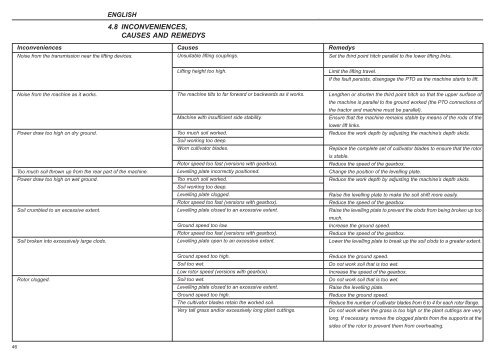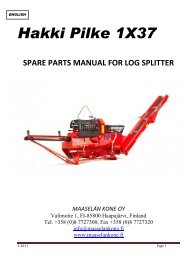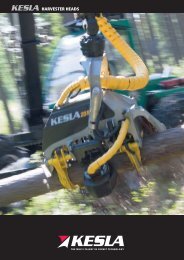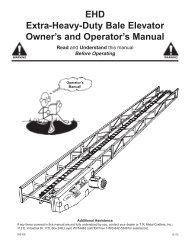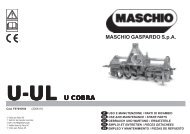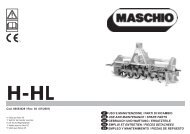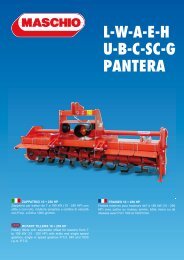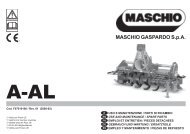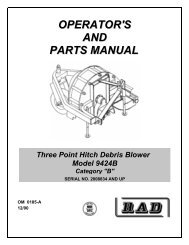G G - COBRA G - CONDOR - JS Woodhouse
G G - COBRA G - CONDOR - JS Woodhouse
G G - COBRA G - CONDOR - JS Woodhouse
- No tags were found...
You also want an ePaper? Increase the reach of your titles
YUMPU automatically turns print PDFs into web optimized ePapers that Google loves.
ITALIANO ENGLISH DEUTSCH FRANÇAIS<br />
ESPAÑOL<br />
4.8 INCONVENIENCES,<br />
CAUSES AND REMEDYS<br />
Inconveniences Causes Remedys<br />
Noise from the transmission near the lifting devices.<br />
Unsuitable lifting couplings.<br />
Set the third point hitch parallel to the lower lifting links.<br />
Lifting height too high.<br />
Limit the lifting travel.<br />
If the fault persists, disengage the PTO as the machine starts to lift.<br />
Noise from the machine as it works.<br />
Power draw too high on dry ground.<br />
Too much soil thrown up from the rear part of the machine.<br />
Power draw too high on wet ground.<br />
Soil crumbled to an excessive extent.<br />
Soil broken into excessively large clods.<br />
The machine tilts to far forward or backwards as it works.<br />
Machine with insufficient side stability.<br />
Too much soil worked.<br />
Soil working too deep.<br />
Worn cultivator blades.<br />
Rotor speed too fast (versions with gearbox).<br />
Levelling plate incorrectly positioned.<br />
Too much soil worked.<br />
Soil working too deep.<br />
Levelling plate clogged.<br />
Rotor speed too fast (versions with gearbox).<br />
Levelling plate closed to an excessive extent.<br />
Ground speed too low.<br />
Rotor speed too fast (versions with gearbox).<br />
Levelling plate open to an excessive extent.<br />
Lengthen or shorten the third point hitch so that the upper surface of<br />
the machine is parallel to the ground worked (the PTO connections of<br />
the tractor and machine must be parallel).<br />
Ensure that the machine remains stable by means of the rods of the<br />
lower lift links.<br />
Reduce the work depth by adjusting the machine’s depth skids.<br />
Replace the complete set of cultivator blades to ensure that the rotor<br />
is stable.<br />
Reduce the speed of the gearbox.<br />
Change the position of the levelling plate.<br />
Reduce the work depth by adjusting the machine’s depth skids.<br />
Raise the levelling plate to make the soil shift more easily.<br />
Reduce the speed of the gearbox.<br />
Raise the levelling plate to prevent the clods from being broken up too<br />
much.<br />
Increase the ground speed.<br />
Reduce the speed of the gearbox.<br />
Lower the levelling plate to break up the soil clods to a greater extent.<br />
Rotor clogged.<br />
Ground speed too high.<br />
Soil too wet.<br />
Low rotor speed (versions with gearbox).<br />
Soil too wet.<br />
Levelling plate closed to an excessive extent.<br />
Ground speed too high.<br />
The cultivator blades retain the worked soil.<br />
Very tall grass and/or excessively long plant cuttings.<br />
Reduce the ground speed.<br />
Do not work soil that is too wet.<br />
Increase the speed of the gearbox.<br />
Do not work soil that is too wet.<br />
Raise the levelling plate.<br />
Reduce the ground speed.<br />
Reduce the number of cultivator blades from 6 to 4 for each rotor flange.<br />
Do not work when the grass is too high or the plant cuttings are very<br />
long. If necessary, remove the clogged plants from the supports at the<br />
sides of the rotor to prevent them from overheating.<br />
46


